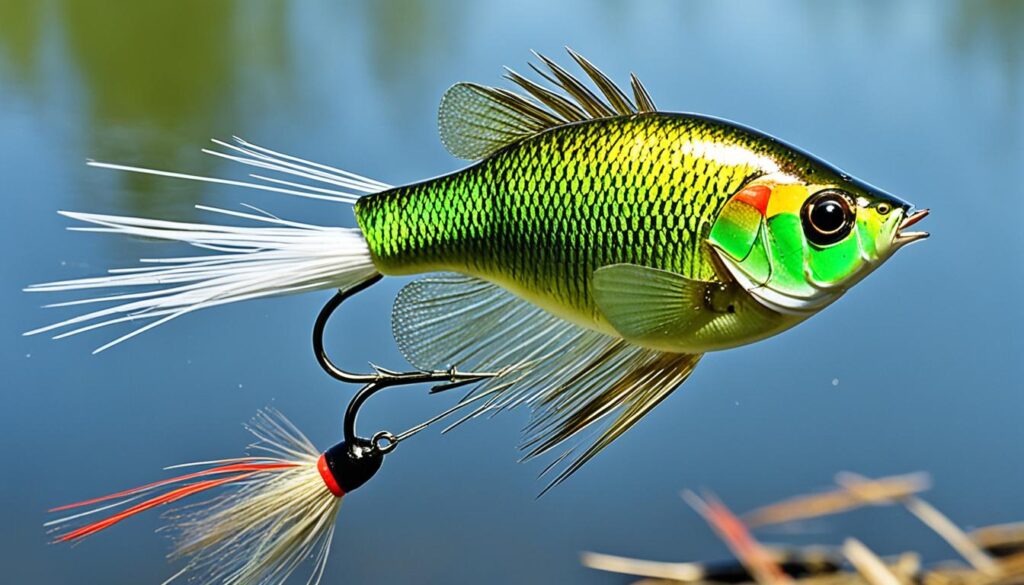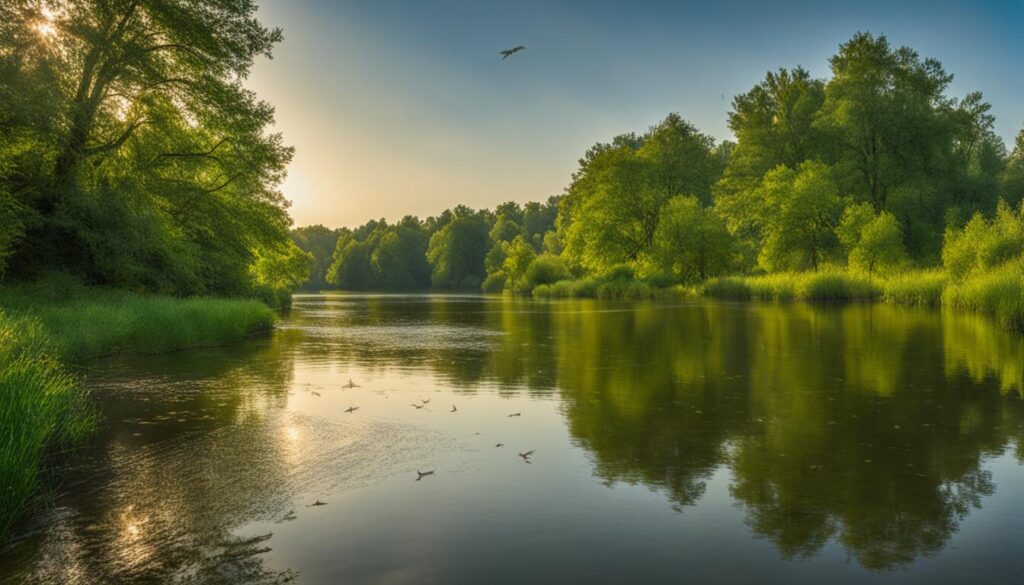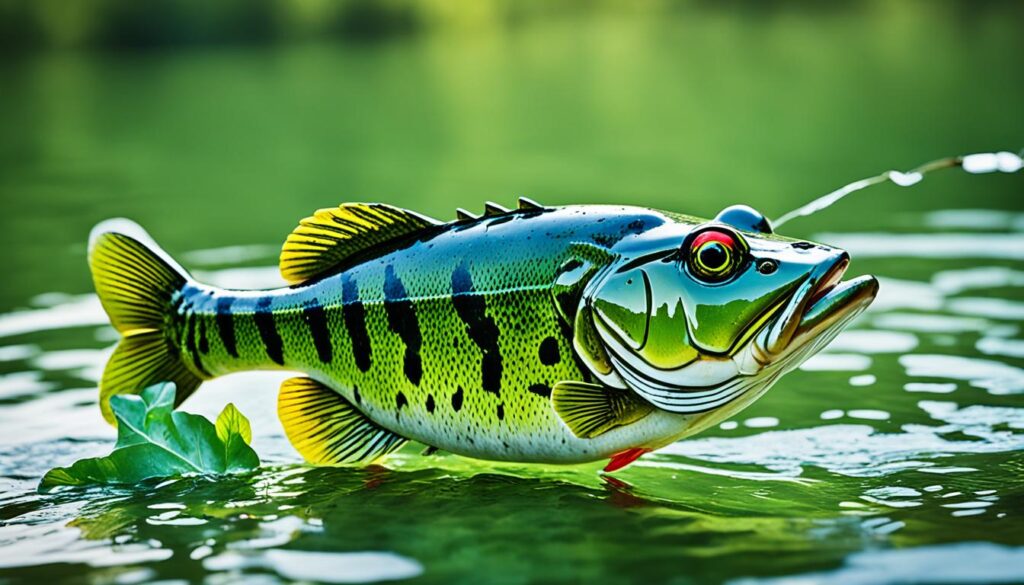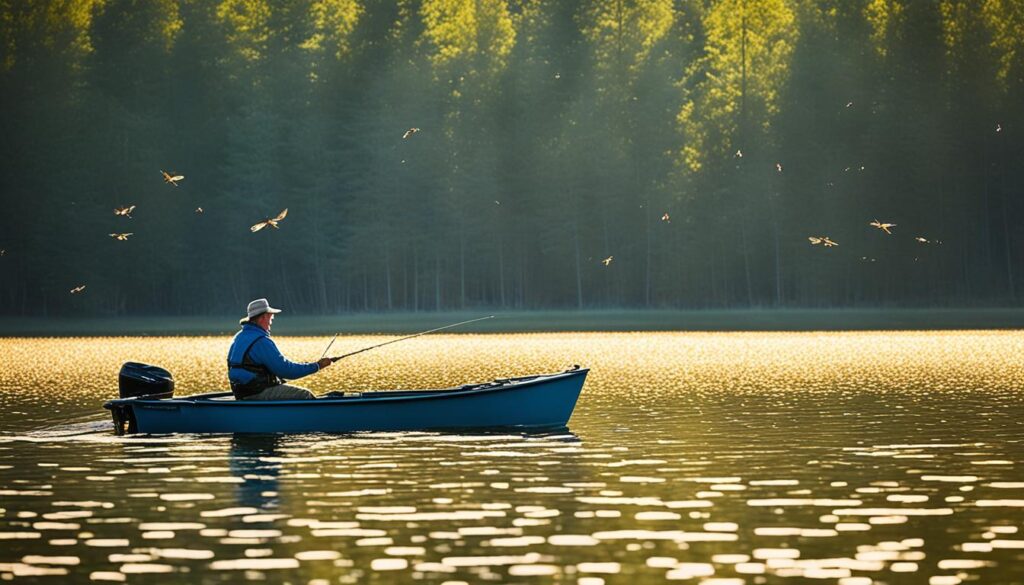When it comes to successful bass fishing, one of the most important strategies is to match the hatch. This means choosing a lure or pattern that resembles the natural food source that bass feed on emerge Spring to autumn, not necessarily in May. The mayfly hatch is one of the most abundant and essential food sources for bass. You may be asking yourself, What is a Mayfly?
Understanding the bass forage species during the summer, such as crayfish, bluegills, shad, yellow perch, frogs, gobies, and mayflies, is crucial for effectively targeting bass during this time. By imitating these natural food sources with the right lures and techniques, you can significantly increase your chances of catching more bass.
Angler’s Essentials
- Matching the hatch is essential in bass fishing to imitate the natural food source.
- The summer mayfly hatch is an important period for bass fishing.
- Understanding the common bass forage species during the summer is crucial.
- Choosing the right lures and techniques to imitate crayfish, bluegills, shad, yellow perch, frogs, gobies, and mayflies can increase your bass catch.
- By effectively matching the summer mayfly hatch, you can have more fun and success on the water.
Understanding Crayfish as Bass Forage
Crayfish are one of the most common bass forage species found in freshwater bodies nationwide. They are especially abundant in rocky areas and aquatic vegetation. Crayfish imitators, such as crankbaits in reds, browns, greens, and skirted jigs, work extremely well in all seasons but are particularly effective during the pre spawn period (March-May). This is when big female bass gorge on crayfish for the minerals their hard shells provide.
During the pre-spawn period, bass is actively seeking out high-calorie meals to fuel their energy levels for the upcoming spawn. Crayfish are a favorite food source for bass during this time, making it essential for anglers to have the best lures for crayfish imitations in their tackle boxes.
When selecting crayfish imitators, it’s essential to consider the color and action of the lure. Crayfish typically range in color from reddish-brown to olive-green, so choosing crankbaits and jigs in these shades can be highly effective. Additionally, incorporating lifelike movements and actions that mimic the natural behaviors of crayfish, such as dragging, hopping, and scurrying along the bottom, can trigger aggressive strikes from bass.
| Lure Type | Features |
|---|---|
| Crankbaits |
|
| Skirted Jigs |
|
Targeting Bass with Bluegill Imitators

When it comes to bass fishing, bluegills play a key role in the bass forage spectrum. These sunfish are abundant in almost every waterbody across the country, making them a prime target for bass. In particular, bass have a strong affinity for bluegills during their spawning season, which occurs in the month after the bass spawn. To effectively target bass during this time, using bluegill imitators can yield great results.
There are several effective lures that mimic bluegills and entice bass to strike. Bluegill pattern square bills, green pumpkin vibrating jigs, swim-jigs, and even swimbaits have proven to be successful in fooling bass into thinking they are preying on bluegills. These lures replicate the natural appearance and swimming action of bluegills, making them irresistible to bass.
When presenting bluegill imitators, it’s crucial to pay attention to the speed and depth at which you retrieve the lure. Varying the retrieval speed and experimenting with different depths can help you imitate the natural behavior of bluegills and trigger more bites from bass. Additionally, targeting areas where bluegills are known to congregate, such as weed edges and rocky structures, can increase your chances of success.
| Lure | Description |
|---|---|
| Square Bills | Lipless crankbaits with a bluegill pattern; effective for shallow to mid-depth presentations |
| Green Pumpkin Vibrating Jigs | Vibrating jigs with a green pumpkin color scheme; ideal for imitating bluegills in a variety of water conditions |
| Swim-Jigs | Jigs with a swimbait-style trailer; mimic the swimming action of bluegills |
| Swimbaits | Realistic soft plastic baits with lifelike bluegill detailing; effective for targeting larger bass |
By using bluegill imitators during the spawning season, you can tap into the bass’s natural feeding instincts and increase your chances of landing more fish. Remember to experiment with retrieval speed, depth, and presentation techniques to find what works best in your fishing spot. So, the next time you hit the water, don’t forget to stock up on bluegill imitators and prepare for an exciting bass fishing adventure!
Fishing with Shad Imitations for Summer Bass
When it comes to bass forage, shad are a predominant food source that bass target during the summer months. Shad are silvery baitfish found in large schools in river systems and reservoirs. They play a vital role in the bass fishing ecosystem, especially during the shad spawn in April and May, as well as during the winter when shad periodically die off due to plummeting water temperatures.
When targeting bass that is actively feeding on shad, anglers should employ shad imitator lures like minnow baits, crankbaits, white bucktail jigs, soft plastic jerk baits, and walking topwater. These lures closely resemble the size, shape, and color of shad, making them irresistible to bass. However, the key challenge lies in selecting the right imitators that most accurately match the shad profile in the specific water body you’re fishing. For genuinely realistic shad imitation, consider the highly effective BEST SWIMBAITS FOR BASS FISHING.
During the shad spawn, when shad is actively reproducing, it’s vital to choose lures that imitate the spawning behavior of shad. This means selecting lures that have a realistic wobbling or rolling action, as well as those that create surface disturbance to mimic spawning shad.
Best Shad Imitators for Bass Fishing
| Lure Type | Description | Popular Brands |
|---|---|---|
| Minnow Baits | Realistic minnow-shaped lures with a wobbling action. | Rapala, Megabass, Strike King |
| Crankbaits | Lures with a wide wobbling action that can dive to specific depths. | Strike King, Bomber, Bandit |
| White Bucktail Jigs | Bucktail jigs with white coloration to mimic shad. | Jigging Master, Spro, Mepps |
| Soft Plastic Jerkbaits | Realistic soft plastic baits that imitate injured or fleeing shad. | Zoom, Yamamoto, Zoom |
| Walking Topwaters | Surface lures that create a side-to-side walking action. | Heddon, Megabass, Lucky Craft |
By using these shad imitators, anglers can effectively mimic the shad forage and increase their chances of enticing bass strikes. It’s important to experiment with different lure actions, sizes, and colors to determine the preferences of the bass in the specific water body you’re fishing. Remember, matching the hatch is key to a successful day of bass fishing.
Targeting Bass with Yellow Perch Imitations
Yellow perch, also known as the “shad of the north,” are a prominent baitfish found in northern natural lakes. When it comes to bass forage, yellow perch play an important role in the diet of bass. During the midsummer through fall months, bass develop a strong preference for yellow perch as they form massive schools along the outside edges of deep weeds.
To effectively target bass during this time, anglers can use a variety of yellow perch imitators in their arsenal. Crankbaits, minnow baits, swimbaits, grubs, and tubes in yellow perch patterns are highly effective in fooling bass into biting. These lures mimic the appearance and swimming action of yellow perch, making them irresistible to hungry bass.
To enhance the effectiveness of yellow perch imitators, anglers can modify shad-colored baits by adding an orange throat and green bars. This color combination closely resembles the markings of a yellow perch and can further entice bass to strike.
Yellow Perch Imitation Lure Recommendations:
| Lure Type | Recommended Brands |
|---|---|
| Crankbaits | Rapala, Strike King, Berkley |
| Minnow Baits | Rebel, Yo-Zuri, LiveTarget |
| Swimbaits | Savage Gear, Keitech, Zoom |
| Grubs | Bobby Garland, Mister Twister, Berkley |
| Tubes | Gary Yamamoto, Strike King, YUM |
By using these yellow perch imitations and targeting areas where yellow perch schools are abundant, anglers can increase their chances of catching bass during the midsummer through fall period. So, make sure to stock up on yellow perch imitators and get ready for some exciting bass fishing action!
Making the Most of Mayfly Hatches

Mayflies are small winged insects that hatch in rivers, ponds, and reservoirs. These delicate creatures serve as important bass forage, attracting hungry fish during their hatches. Mayfly hatches can occur from April throughout the summer, depending on the species.
When a significant mayfly hatch takes place, it’s common for all fish to gorge on these insects exclusively. While this abundance of natural food may make fishing more challenging, there are effective strategies for targeting bass during mayfly hatches and triggering reaction strikes.
During a mayfly hatch, it’s crucial to present your lure in a way that imitates the natural movement and behavior of the insects. Flipping and pitching with a heavy weight allows for precise and accurate casts, delivering the lure to the exact spot where bass are most likely to be feeding. Fast-moving baits like crankbaits and spinnerbaits can also elicit reaction strikes from bass that are in an aggressive feeding mood during mayfly hatches.
Using the right lures and techniques during mayfly hatches can greatly increase your chances of success on the water. By matching the appearance and behavior of the mayflies, you will be effectively imitating the bass’s primary food source and enticing them to strike.
During a mayfly hatch, triggering reaction strikes is crucial. Flipping, pitching with a heavy weight, and using fast-moving baits like crankbaits and spinnerbaits can be effective in triggering these reaction strikes.
Fooling Bass with Frog Imitations

Frogs are amphibians that inhabit shoreline habitats, particularly areas of vegetation like lily pad fields and marshy areas. While bass will seldom turn down a frog swimming lazily over their heads, the prime time to capitalize on the frog bite is from midsummer through the early fall when the frog population is at its highest and vegetation growth provides optimal cover. Hollow-bodied and soft plastic buzz toads are excellent frog imitations for bass.
The lifelike appearance and action of frog imitations can trigger aggressive strikes from bass, who see these creatures as a tasty and easily accessible meal. The silhouette, color, and movement of a frog lure are key factors in fooling bass into biting. As with any bait, it’s important to experiment with different retrieves, speeds, and pauses to find the combination that is most effective on a given day.
Hollow-bodied frogs are designed to float on the surface and imitate a frog sitting on lily pads or other vegetation. These lures typically have a weedless design, allowing anglers to cast into heavy cover without worrying about getting snagged. They can be worked across the top of the water, mimicking the movements of a real frog. The soft plastic buzz toads, on the other hand, are more versatile and can be fished both on the surface and just below it.
When fishing with frog imitations, it’s important to focus on areas where bass are likely to be hiding, such as around weed mats, lily pads, fallen trees, and other forms of cover. Cast your lure past the target area and retrieve it slowly, creating a wake or a series of gentle hops to mimic a frog swimming or hopping from one lily pad to another.
For added realism, you can pause your retrieve, allowing the lure to sit momentarily before giving it a slight twitch or jiggle to mimic a frog’s movement. This can often entice bass to strike as they are attracted to the vibrations and commotion caused by a struggling frog.
Top Frog Imitations for Bass Fishing
| Frog Imitation | Description |
|---|---|
| 1. LIVETARGET Hollow Body Frog | Award-winning frog lure with lifelike details, weedless design, and natural swimming action. |
| 2. Spro Bronzeye Frog 65 | A proven favorite among anglers, this frog features a soft body, sharp hooks, and realistic colors. |
| 3. BOOYAH Pad Crasher | A durable and affordable option, this frog lure delivers a steady, enticing action on the surface. |
| 4. Strike King KVD Sexy Frog | A versatile lure with lifelike features and a realistic swimming motion that drives bass crazy. |
| 5. Berkley PowerBait Pit Boss | A soft plastic bait that can be rigged weedless and used as a frog imitation in dense cover. |
Using a combination of realistic frog imitations, strategic casts, and accurate retrieves, you can fool bass into thinking they’re encountering a live frog and trigger aggressive strikes. The midsummer through early fall period is the perfect time to target bass with frog imitations, so be sure to add them to your arsenal of bass fishing lures.
Targeting Bass with Goby Imitations
Gobies, an invasive species in the Great Lakes, have become a predominant bottom fish species throughout the system. Gobies serve as a main food source for all Great Lakes game fish species. Mimicking gobies with drop shot rigs, tube jigs, and football jigs is effective for catching bass. Gobies don’t have swim bladders, so imitating their darting action by rapidly hopping or stroking your bait off the bottom can trigger aggressive strikes from bass.
If you want to improve your bass fishing success in the Great Lakes, it’s important to understand the role of gobies as a primary bass forage. By imitating the behavior and appearance of gobies with the right lures and techniques, you can increase your chances of catching more bass.
When fishing for bass with goby imitations, consider using the following strategies:
- Drop shot rigs: Rigging a goby imitation on a drop shot setup allows you to present the lure in a natural hovering position, mimicking the behavior of gobies on the lake bottom.
- Tube jigs: Thread a goby-colored tube jig onto a leadhead jig and fish it near rocky structures or along weed edges. The twitching action and realistic appearance of the tube jig can entice bass to strike.
- Football jigs: Use football jigs with goby-colored skirts and realistic baitfish trailers to imitate the movement and profile of gobies on the lake bottom. This technique works particularly well when targeting bass in deeper water.
When retrieving your goby imitations, try to mimic the darting and twitching action of gobies by rapidly hopping or stroking your bait off the bottom. This erratic movement can trigger aggressive strikes from bass looking to prey on these bottom-dwelling fish.
I’ve had great success targeting bass with goby imitations in the Great Lakes. The natural appearance and behavior of gobies make them an irresistible meal for bass. Using drop shot rigs, tube jigs, and football jigs in goby patterns has consistently led to more bass in my boat. Give it a try and see the difference it can make in your bass fishing success!
Incorporating goby imitations into your bass fishing arsenal can be a game-changer when fishing the Great Lakes. By understanding the importance of gobies as a bass forage and utilizing the right imitations and techniques, you’ll have a higher chance of landing trophy-sized bass. So grab your gear, head out to the Great Lakes, and start targeting bass with goby imitations!
| Lure Type | Description |
|---|---|
| Drop shot rigs | Rigging a goby imitation on a drop shot setup allows for a natural hovering presentation. |
| Tube jigs | Goby-colored tube jigs mimicking the movement and profile of gobies on the lake bottom. |
| Football jigs | Using football jigs with goby-colored skirts and realistic baitfish trailers to imitate gobies on the lake bottom. |
Conclusion
Matching the summer mayfly hatch is a proven technique that can significantly boost your bass catch rates. To make the most of this opportunity, it is essential to have a thorough understanding of the common bass forage species and employ the right lures and techniques. By imitating crayfish, bluegills, shad, yellow perch, mayflies, frogs, and gobies, you can effectively target bass during the mayfly hatch and enhance your fishing experience.
When it comes to bass fishing, using specific imitators for each forage species is key. Crayfish imitators, such as crankbaits and skirted jigs, work wonders during the prespawn period. Bluegill imitators like square bills, vibrating jigs, and swimbaits are ideal for fooling bass during the spawning season.
Shad imitations like minnow baits, crankbaits, and soft plastic jerkbaits are highly effective, especially during the shad spawn and winter months. Yellow perch imitations in the form of crankbaits, tubes, and swimbaits can produce great results from midsummer through fall.
To tackle the challenge of the mayfly hatch, triggering reaction strikes is crucial. Flipping, pitching with a heavy weight, and using fast-moving baits like crankbaits and spinnerbaits can help prompt the bass into biting. Additionally, frog imitations, particularly in midsummer through early fall, can be successful when bass are actively preying on frogs.
Finally, if you’re fishing in the Great Lakes region, incorporating goby imitations such as drop shot rigs, tube jigs, and football jigs is highly recommended. These bottom-dwelling fish are a staple diet for bass in these waters, and mimicking their darting action can entice aggressive strikes.
Remember, successful bass fishing during the summer mayfly hatch depends on your ability to adapt to the specific forage species and use the appropriate imitations and techniques. So get out there, match the summer mayfly hatch, and maximize your bass catch!
FAQ
How can I match the summer mayfly hatch to catch more bass?
To match the summer mayfly hatch and increase your bass catch, it is important to understand the most common bass forage species and choose lures that mimic them. Crayfish, bluegills, shad, yellow perch, mayflies, frogs, and gobies are all important for bass fishing success during the summer mayfly hatch. By using the right imitators and techniques, anglers can successfully target bass and have more fun on the water.
What are some effective crayfish imitators for bass fishing?
Crayfish imitators like crankbaits in reds, browns, and greens, and skirted jigs work extremely well in all seasons, especially during the prespawn period (March – May). These lures closely resemble crayfish, which are one of the most common bass forage species. Big female bass gorge on crayfish during the prespawn period for the minerals their hard shells provide.
How can I target bass using bluegill imitators?
Bluegill pattern square bills, green pumpkin vibrating jigs, swim-jigs, and even swimbaits are effective in fooling bass targeting bluegills. Bluegills are a primary bass forage species, and bass are particularly fond of them during their spawning season, which occurs in the month after the bass spawn. By imitating bluegills with these lures, anglers can entice bass to bite.
What are some effective shad imitations for catching bass in the summer?
Shad pattern minnow baits, crankbaits, white bucktail jigs, soft plastic jerkbaits, and walking topwaters like the Heddon Zara Spook and Yamamoto Tate are effective in drawing strikes from bass during the summer. Shad are silvery baitfish that are a predominant food source for bass, especially during the shad spawn (April – May) and winter. By imitating shad with these lures, anglers can target bass feeding on shad.
How can I imitate yellow perch to catch bass during the summer?
Crankbaits, minnow baits, swimbaits, grubs, and tubes in yellow perch patterns are effective perch imitators. Yellow perch are a predominant baitfish in northern natural lakes, and bass become especially fond of them from midsummer through the fall. Adding an orange throat and green bars to shad-colored baits can also mimic perch. By imitating yellow perch, anglers can target bass during this period.
What techniques can I use to capitalize on mayfly hatches and catch more bass?
During a mayfly hatch, triggering reaction strikes is crucial as all fish tend to gorge on mayflies exclusively. Flipping and pitching with a heavy weight, as well as using fast-moving baits like crankbaits and spinnerbaits, can be effective in triggering these reaction strikes. By using these techniques, anglers can successfully target bass during a mayfly hatch and increase their catch rates.
How can I fool bass with frog imitations?
Hollow-bodied and soft plastic buzz toads are excellent frog imitations for bass. Bass are particularly fond of frogs, especially from midsummer through the early fall when the frog population is at its highest and vegetation growth provides optimal cover. By using these frog imitations, anglers can effectively fool bass and increase their chances of a successful catch.
How can I imitate gobies to catch bass in the Great Lakes?
Mimicking gobies with drop shot rigs, tube jigs, and football jigs is effective for catching bass in the Great Lakes. Gobies have become a predominant bottom fish species throughout the system and serve as a main food source for all Great Lakes game fish species. By imitating gobies, anglers can target bass in these waters and increase their chances of success.
What are some general tips for increasing my bass catch during the summer mayfly hatch?
To increase your bass catch during the summer mayfly hatch, it is important to understand the common bass forage species and know how to imitate them with the right lures and techniques. By using crayfish imitators, bluegill imitators, shad imitators, yellow perch imitators, mayfly hatch strategies, frog imitations, and goby imitations, anglers can successfully target bass and have more fun on the water.
